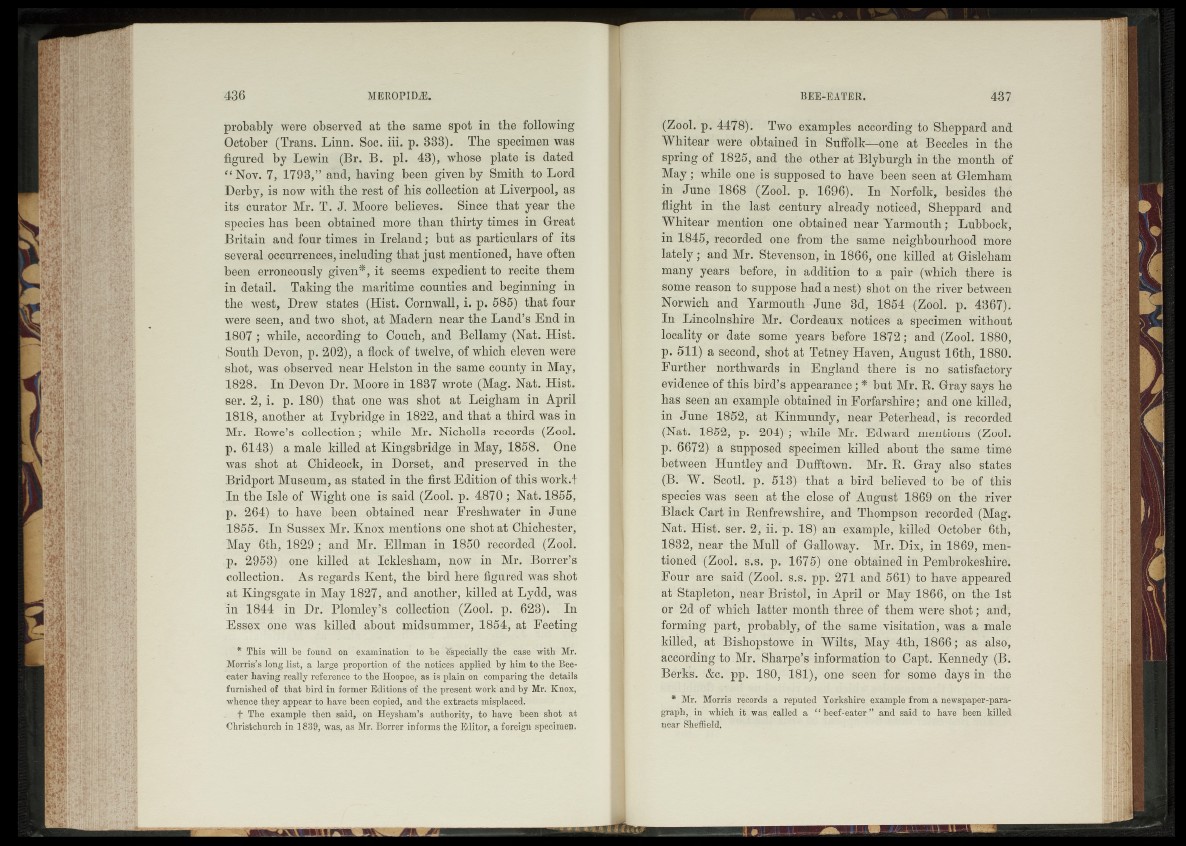
probably were observed at the same spot in the following
October (Trans. Linn. Soc. iii. p. 333). The specimen was
figured by Lewin (Br. B. pi. 43), whose plate is dated
“ Nov. 7, 1793,” and, having been given by Smith to Lord
Derby, is now with the rest of his collection at Liverpool, as
ittf curator Mr. T. J. Moore believes. Since that year the
species has been obtained more than thirty times in Great
Britain and four times in Ireland; but as particulars of its
several occurrences, including that just mentioned, have often
been erroneously given*, it seems expedient to recite them
in detail. Taking the maritime counties and beginning in
the west, Drew states (Hist. Cornwall, i. p. 585) that four
were seen, and two shot, at Madern near the Land’s End in
1807; while, according to Couch, and Bellamy (Nat. Hist.
South Devon, p. 202), a flock of twelve, of which eleven were
shot, was observed near Helston in the same county in May,
1828. In Devon Dr. Moore in 1837 wrote (Mag. Nat. Hist,
ser. 2, i. p. 180) that one was shot at Leigham in April
1818, another at Ivybridge in 1822, and that a third was in
Mr. Rowe’s collection; while Mr. Nicholls records (Zool.
p. 6143) a male killed at Kingsbridge in May, 1858. One
was shot at Chideock, in Dorset, and preserved in the
Bridport Museum, as stated in the first Edition of this work.f
In the Isle of Wight one is said (Zool. p. 4870; Nat. 1855,
p. 264) to have been obtained near Freshwater in June
1855. In Sussex Mr. Knox mentions one shot at Chichester,
May 6th, 1829 ; and Mr. Ellman in 1850 recorded (Zool.
p. 2953) one killed at Icklesham, now in Mr. Borrer’s
collection. As regards Kent, the bird here figured was shot
at Kingsgate in May 1827, and another, killed at Lydd, was
in 1844 in Dr. Plomley’s collection (Zool. p. 623). In
Essex one was killed about midsummer, 1854, at Feeting
* This will be found on examination to be Especially the case with Mr.
Morris’s long list, a large proportion of the notices applied by him to the Bee-
eater having really reference to the Hoopoe, as is plain on comparing the details
furnished of that bird in former Editions of the present work and by Mr. Knox,
whence they appear to have been copied, and the extracts misplaced.
f The example then said, on Heysham’s authority, to have been shot at
Christchurch in 1839, was, as Mr. Borrer informs the Editor, a foreign specimen.
(Zool. p. 4478). Two examples according to Sheppard and
Whitear were obtained in Suffolk—one at Beccles in the
spring of 1825, and the other at Blyburgh in the month of
May; while one is supposed to have been seen at Glemham
in June 1868 (Zool. p. 1696). In Norfolk, besides the
flight in the last century already noticed, Sheppard and
Whitear mention one obtained near Yarmouth; Lubbock,
in 1845, recorded one from the same neighbourhood more
lately; and Mr. Stevenson, in 1866, one killed at Gisleham
many years before, in addition to a pair (which there is
some reason to suppose had a nest) shot on the river between
Norwich and Yarmouth-June 3d, 1854 (Zool. p. 4367).
In Lincolnshire Mr. Cordeaux notices a specimen without
locality or date some years before 1872; and (Zool. 1880,
p. 511) a second, shot at Tetney Haven, August 16th, 1880.
Further northwards in England there is no satisfactory
evidence of this bird’s appearance; * but Mr. R. Gray says he
has seen an example obtained in Forfarshire; and one killed,
in June 1852, at Kinmundy, near Peterhead, is recorded
(Nat. 1852, p. 204); while Mr. Edward mentions (Zool.
p. 6672) a supposed specimen killed about the same time
between Huntley and Dufftown. Mr. R. Gray also states
(B. W. Scotl. p. 513) that a bird believed to be of this
species was seen at the close of August 1869 on the river
Black Cart in Renfrewshire, and Thompson recorded (Mag.
Nat. Hist. ser. 2, ii. p. 18) an example, killed October 6th,
1832, near the Mull of Galloway. Mr. Dix, in 1869, mentioned
(Zool. s.s. p. 1675) one obtained in Pembrokeshire.
Four are said (Zool. s.s. pp. 271 and 561) to have appeared
at Stapleton, near Bristol, in April or May 1866, on the 1st
or 2 d of which latter month three of them were shot; and,
forming part, probably, of the same visitation, was a male
killed, at Bishopstowe in Wilts, May 4th, 1866 ; as also,
according to Mr. Sharpe’s information to Capt. Kennedy (B.
Berks. &c. pp. 180, 181), one seen for some days in the
* Mr. Morris records a reputed Yorkshire example from a newspaper-paragraph,
in which it was called a “ beef-eater” and said to have been killed
near Sheffield.